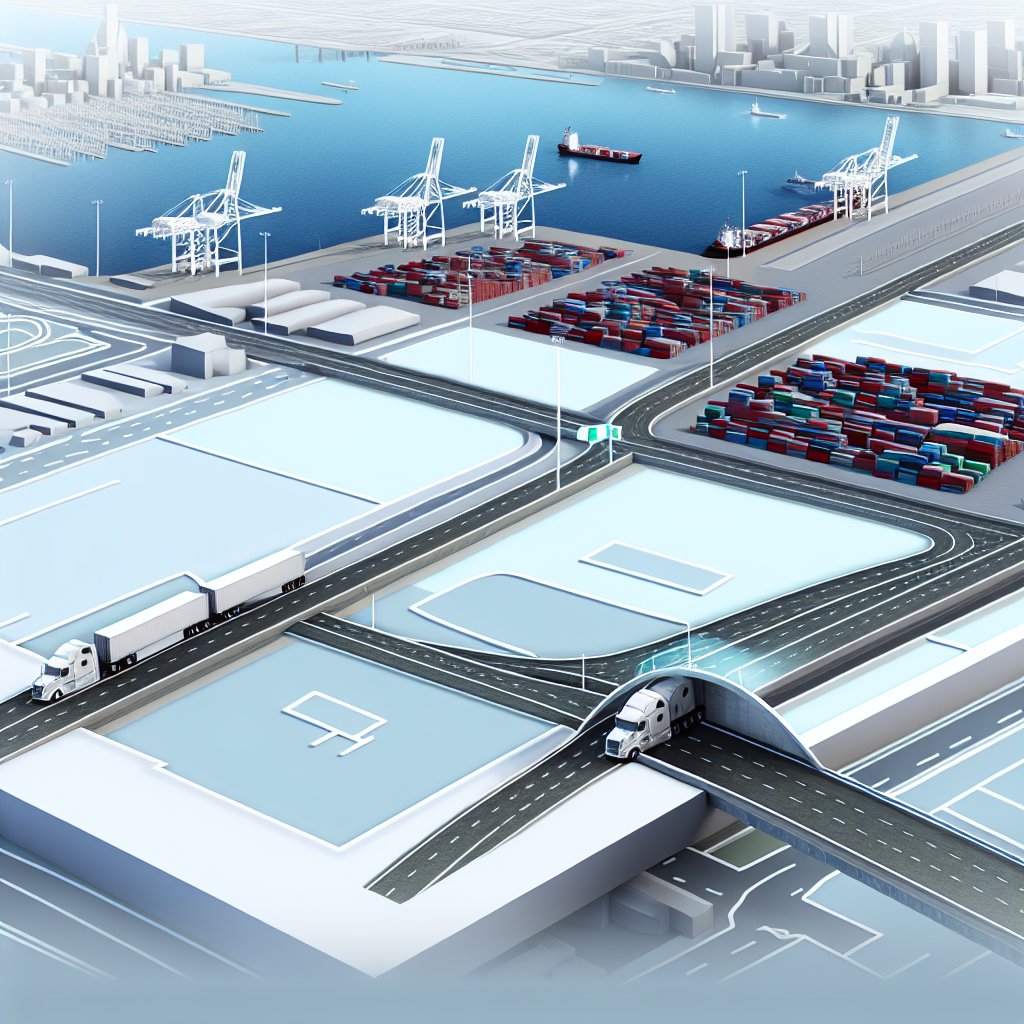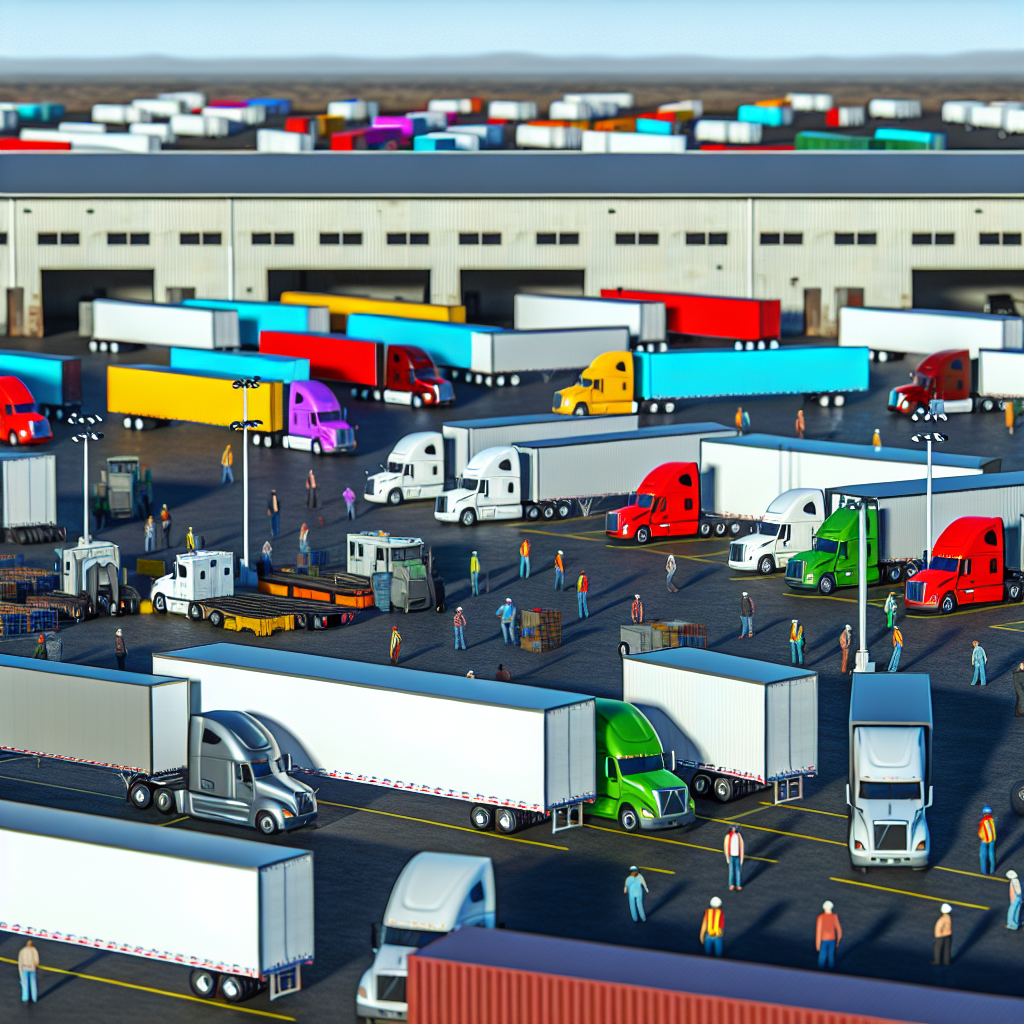The Montreal Port Expansion is a pivotal development in Canada’s trading infrastructure that will have significant implications for the commercial trucking industry. This expansion aims to increase capacity by approximately 60%, which is crucial in keeping goods moving efficiently amidst growing demand. As supply chains face unprecedented challenges, the enhancements to the port’s infrastructure will not only streamline logistics but also diversify trade routes. With projected annual economic benefits of around $140 million, these improvements are set to bolster employment and strengthen trade corridors within Eastern Canada and beyond.
Key to this initiative is the Contrecœur terminal project, which was recently recognized as one of the country’s first five nation-building projects by Prime Minister Mark Carney. This recognition underscores the importance of investing in modern, efficient trading infrastructure that can support a robust supply chain system. As the Montreal Port expands its capacity and capabilities, it opens new avenues for trade, ultimately empowering Canadian workers while reinforcing the nation’s position in the global market. This monumental project not only addresses immediate logistical needs but also reflects a strategic vision aimed at fostering long-term economic growth.
The Economic Benefits of the Montreal Port Expansion
The economic benefits of the Montreal Port expansion are substantial and multifaceted. Here are the key highlights:
- Annual Economic Impact: The expansion is projected to generate approximately $140 million in annual economic benefits across Quebec and Canada. This infusion of capital will contribute significantly to regional and national economic growth.
- Jobs Creation: The project is anticipated to create thousands of new jobs, benefiting local communities and supporting families. As infrastructure develops, sectors such as logistics, transportation, and port operations will thrive, leading to increased employment opportunities.
- Infrastructure Investment: This expansion demonstrates a commitment to modernizing trading infrastructure. Enhanced facilities at the Port of Montreal will improve efficiency and reliability, vital for meeting the increasing demand for goods moving in and out of Eastern Canada.
- Increased Trade Capacity: With a 60% increase in capacity at the Port of Montreal, businesses can now access new markets and diversify their trade routes. This growth response will stimulate commerce not just locally, but also nationally, as businesses capitalize on improved resource flow.
- Support for Primary Industries: The port is a crucial player in Canada’s grain exports, and its expansion will further strengthen this position. The increase in capacity will likely improve export operations, benefiting agricultural producers and contributing to the national economy.
- Government Support: As Prime Minister Mark Carney stated, “This project will expand the Port of Montreal’s capacity by approximately 60%… to give Eastern Canada the trading infrastructure it needs.” This governmental support indicates a national strategy that recognizes and prioritizes investment in critical infrastructure.
The Montreal Port expansion is more than just an infrastructure improvement; it represents a strategic investment in the economy that will yield substantial returns in job creation, trade capability, and overall economic vitality.


The expansion of the Montreal Port is set to have a transformative effect on commercial trucking infrastructure and the broader supply chain dynamics in Eastern Canada. As the Port works to increase its capacity by approximately 60%, the implications for trucking are profound, particularly concerning how goods move and how efficiently supply chains operate.
One significant aspect of the expansion is the development of the Contrecœur terminal, which has been recognized as one of Canada’s first five nation-building projects. This facility is aimed at enhancing trade connectivity, which will lead to improved trading infrastructure across the region. By providing better access and increased capacity, the Contrecœur terminal will facilitate smoother logistics operations, enabling trucks to operate more efficiently.
These advancements will also contribute to decreased congestion on roadways leading to the Port. As improvements in trading infrastructure take shape, trucking companies can expect reduced travel times and lower operational costs due to streamlined processes and optimized routes. The enhancement of supply chains means that trucks will be able to move more goods with greater ease, satisfying the increasing demand for on-time deliveries that businesses and consumers expect.
Moreover, the expansion is anticipated to create significant economic benefits, generating approximately $140 million annually across Quebec and Canada. This influx is likely to stimulate job creation, leading to a higher demand for trucking services as businesses ramp up their operations to exploit new market opportunities opened by the port expansion.
As rail capacity is optimized within the port, with additional tracks and terminals being developed, there may also be a shift in freight patterns. While some trucking routes may become less utilized due to an increase in rail shipments, the overall demand for trucking services will likely increase as the volume of goods transiting through Montreal grows. This shift necessitates adaptability within the trucking industry, encouraging firms to seek innovative solutions to remain competitive in an evolving landscape.
In summary, the Montreal Port expansion will significantly transform the commercial trucking infrastructure, enhancing supply chains and trade corridors in Eastern Canada. The focus on modernized infrastructure and increased capacity will ultimately benefit the trucking industry through improved efficiencies, reduced congestion, and greater economic growth opportunities.
| Route Type | Existing Route | Potential New Route | Distance (km) | Time Savings (hrs) | Economic Benefits |
|---|---|---|---|---|---|
| Direct Route | Highway 20 | New access road via Highway 132 | 140 | 1 | Increased freight capacity |
| Alternate Route | Route 132 | Highway 30 new connection | 180 | 1.5 | Lower fuel costs, reduced congestion |
| Long Haul Route | Route 138 | New loop via Autoroute 40 | 220 | 2 | More efficient long-distance transport |
| Cargo Transport Route | Port’s current access from Route 132 | New terminal route | 100 | 0.5 | Construction contracts for trucking |
| Industry-Specific Routes | Routes serving local industries | Dedicated routes for grain transport | 160 | 1 | Improved access to grain handling |
Government Support
The Montreal Port expansion project has garnered substantial support from the government, with Prime Minister Mark Carney emphasizing its importance as a key component of Canada’s nation-building initiatives. The Contrecœur Terminal Container Project has been recognized as one of the first five nation-building projects, underscoring the federal government’s commitment to investing in critical infrastructure that promotes economic growth and enhances trade capacity.
Mark Carney stated, “At this moment of transformative change, Canada’s new government is focused on delivering major projects to connect our communities, empower Canadian workers, and build Canada’s strength.” This statement encapsulates the government’s vision of how such initiatives will not only expand economic output but also serve as a vital link in creating robust trade corridors that can adapt to changing market demands, thereby fostering long-term prosperity across the nation.
The Montreal Port expansion is projected to increase the port’s capacity by approximately 60%, facilitating the movement of goods and diversifying Canada’s trade routes. In addition to bolstering the supply chain for critical products, the expansion is expected to generate significant economic benefits, estimated at approximately $140 million annually across Quebec and Canada, while creating thousands of jobs in the process.
Furthermore, the government’s investment in this project aligns seamlessly with its broader infrastructure funding plan, which allocates $5 billion towards modernizing essential trade infrastructure, including ports and highways. This move emphasizes a strategic priority for the government to enhance Canada’s position in international trade, support local economies, and ultimately contribute to the realization of a thriving, interconnected Canadian marketplace.
In conclusion, the government’s active role in championing the Montreal Port expansion exemplifies the broader theme of nation-building projects, which are vital for economic growth, job creation, and strengthening Canada’s place in global trade. Such initiatives not only reflect a commitment to infrastructure but also an aspiration to empower communities and drive transformative economic changes across the country.
The Importance of Trade Diversification Through the Montreal Port Expansion
Trade diversification is crucial for enhancing economic resilience, particularly in regions like Eastern Canada that heavily rely on specific ports for exports. The Montreal Port Expansion, which increases the port’s capacity by approximately 60%, serves as a significant opportunity to broaden trade routes and partnerships.
Port of Vancouver’s Role
The Port of Vancouver is pivotal in this context, as it accounts for over 50% of Canada’s grain exports, facilitating approximately $305 billion in goods annually. In 2024, it managed a record 158 million metric tonnes of cargo, reflecting a strong performance in various sectors. This level of output contributes to Canada’s wider economic health.
The expansion at the Montreal Port further enhances trade diversity for Eastern Canada, leading to improved shipping routes and access to global markets. The coordination between Montreal and Vancouver allows increased logistical efficiency, providing alternatives to existing trade routes and reducing dependency on singular channels. This diversification helps buffer local economies against market fluctuations, ensuring a broader distribution of goods and opportunities.
Economic Benefits
The economic impact of the Montreal Port expansion will be substantial. By enhancing capacity, it is projected to generate approximately $140 million in annual economic benefits and support thousands of jobs in port operations and related sectors. This influx will stimulate local economies, promoting further investment and development in the region.
In conclusion, the expansion of the Montreal Port is not merely an infrastructure improvement; it represents a strategic investment in Canada’s economy that will yield substantial returns in trade capability, job creation, and overall economic strength.
Conclusion
The expansion of the Montreal Port is a transformative initiative that prioritizes economic growth, job creation, and strengthened trade routes. With an anticipated capacity increase of approximately 60%, the expansion will enhance the efficiency of commercial trucking infrastructure, benefiting countless businesses and communities dependent on trade. From the projected $140 million in annual economic benefits to the creation of thousands of jobs both during construction and operation, this project showcases a forward-thinking approach to improving Canada’s trading capabilities.
The government’s commitment to support nation-building projects like this exemplifies its recognition of the importance of comprehensive infrastructure investment. As the Port of Montreal evolves, it sets the stage for Eastern Canada to become a hub of international commerce. Ultimately, this initiative represents not just an upgrade in physical infrastructure, but a significant step towards long-term economic stability, increased employment opportunities, and a robust future for trade in Canada.
Conclusion
The Montreal Port expansion is a transformative initiative aimed at promoting economic growth, creating jobs, and enhancing trade routes. Anticipating a roughly 60% increase in capacity will improve the efficiency of commercial trucking infrastructure, benefiting countless businesses and communities reliant on trade. The projected $140 million in annual economic benefits and the creation of thousands of jobs during both construction and operation highlight a forward-thinking approach to advancing Canada’s trade capabilities.
The government’s commitment to supporting projects like this reflects a deep understanding of the need for comprehensive infrastructure investment. As the Port of Montreal evolves, it positions Eastern Canada as a growing hub of international commerce. Ultimately, this initiative represents not only an upgrade in physical infrastructure but also a significant stride toward lasting economic stability, expanded employment opportunities, and a vibrant trade future for Canada.
User Adoption Data Related to Montreal Port Expansion
The expansion of the Montreal Port, particularly through the Contrecœur project, has significantly influenced user adoption of new trade routes and infrastructure improvements in commercial trucking and logistics. Here’s a summary of the key findings:
Trade Volume and Diversification
- Container Traffic Growth: In the first half of 2025, the Port of Montreal reported a 4% increase in container traffic, with monthly containerized tonnage exceeding the previous year’s average by 14% since March. This surge indicates a rising demand for trucking and logistics services to manage the higher volume of cargo, showcasing how the expansion has enhanced operational capacity. [source]
- Diversified Trade Partnerships: Trade with major partners has flourished, with exports to China increasing by 22% and trade with Spain experiencing a remarkable 147% rise. Additionally, volumes to Northern Europe climbed by 10%. This diversification is crucial for adapting logistics strategies to fulfill varying international shipping demands. [source]
Infrastructure Enhancements
- Contrecœur Expansion Project: Slated to augment the port’s container-handling capacity to 3.15 million TEUs by 2030, this project is projected to create 8,000 jobs during its construction phase. The expansion will alleviate congestion and bolster cargo handling efficiency, resulting in significant operational improvements for trucking companies. [source]
Economic Impact
- Job Creation and Economic Contribution: Currently, port activities support around 590,000 jobs, contributing nearly $93.5 billion to the economic activity. The anticipated expansions are expected to deepen employment opportunities in trucking and logistics, reflecting the port’s integral role in Canada’s economic landscape. [source]
Challenges and Resilience
- Labor Disputes: Towards the end of 2024, labor disputes at the port caused partial shutdowns, affecting about 40% of container traffic. These disruptions propelled the need for resilient logistics networks to withstand operational challenges and emphasized the importance of contingency planning within trucking operations. [source]
In summary, the Montreal Port’s recent expansion has led to significant user adoption of enhanced trade routes and infrastructure improvements, resulting in increased trade volumes, diversified partnerships, and economic benefits for the region, despite facing some operational challenges. This evolution underscores the importance of ongoing investment in logistics and infrastructure to support Canada’s growing trade ambitions.
The Human Side of the Montreal Port Expansion
As the Montreal Port expansion unfolds, it is reshaping the lives and aspirations of many in the Contrecœur area. This monumental infrastructure project promises vast economic opportunities, but it also stirs deep concerns among local residents and stakeholders.
Residents of Contrecœur express mixed feelings about the expansion. On one hand, community members like Marc, a truck driver with 15 years of experience, see the project as a beacon of hope. “This expansion could mean more jobs and business for us,” he says, contemplating the potential for steady work and a better life for his family. With the promise of 8,000 direct and indirect jobs during peak construction and more than 1,000 permanent positions afterward, many like Marc are eager for the chance to thrive economically.
On the other hand, the expansion brings trepidation. Hélène Reeves, a local environmental advocate, leads a movement down the streets of Contrecœur, rallying against what she describes as an unnecessary and harmful infrastructure project. “We need to question the integrity of such a massive increase in capacity. What will it mean for our health and our environment?” she says amidst a chorus of supporters during a recent demonstration. This tug-of-war of aspirations and apprehensions underscores the complex relationship the community has with the port’s growth.
The Montreal Port Authority (MPA) is trying to navigate this divide by actively engaging with the community. They’ve organized open houses to discuss the developments and listen to citizen concerns, displaying an intent to mitigate worries while emphasizing the infrastructural benefits the port can bring. The MPA has proposed mutual benefit agreements aimed at ensuring that local communities are not just onlookers but participants in this transformation.
Many local small business owners view the expansion as a catalyst for economic revitalization. John and Maria, who run a logistics company, highlight how improved port access could bring new business opportunities. “With more capacity, we can facilitate more trade and help grow our local economy,” John explains, his eyes filled with cautious optimism. Their business relies heavily on efficient transportation networks, and they believe the port’s expansion can make their operations more competitive.
However, the shadow of labor disputes also looms large. Recent conflicts at the port remind everyone of the delicate balance between growth and the workforce’s well-being. MPA CEO Julie Gascon warned of the negative economic impacts on logistics jobs and workers if disputes persist, stating clearly that maintaining a healthy work environment is paramount to the success of the expansion.
In the end, the Montreal Port expansion is not merely an infrastructural upgrade; it is a pivotal chapter in the narrative of local families, workers, and businesses. While promising a horizon filled with job opportunities and economic uplift, it simultaneously challenges residents like Hélène to engage in environmental stewardship. As this chapter unfolds, the balance between progress and preservation remains a constant conversation—a dialogue that defines the heart of the Contrecœur community and its relationship with the future of trade in Canada.


